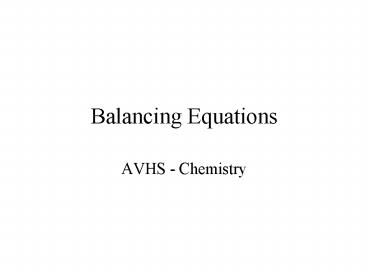Balancing Equations - PowerPoint PPT Presentation
1 / 13
Title:
Balancing Equations
Description:
Balancing Equations AVHS - Chemistry The Law of Conservation of Mass states that in a chemical reaction there is no loss of mass. So, this means that every atom that ... – PowerPoint PPT presentation
Number of Views:26
Avg rating:3.0/5.0
Title: Balancing Equations
1
Balancing Equations
- AVHS - Chemistry
2
- The Law of Conservation of Mass states that
- in a chemical reaction there is no loss of mass.
- So, this means that every atom that is present
- in the beginning of a reaction must be present
- at the end of the reaction.
- Remember, reactions are simply moving
- atoms around. Balancing is just keeping track
- of them.
3
- Let's now look at some examples of writing
- and balancing chemical equations.
- Problem Hydrogen (H2) burns in oxygen
- (O2) to form water (H2O).
- Hmmm. What kind of reaction is this?
4
- Lets begin by writing a word description of
- the problem. From the information given
- above, we have
- hydrogen oxygen ----------gt water
- This will not be necessary forever, but it is a
- nice Baby step in the beginning!
5
- The next step is to replace each name with its
- corresponding chemical formula.
- The formulas were all given in the problem,
- so we have,
- H2 O2 ----------gt H2O
6
- H2 O2 ----------gt H2O
- Looking at the equation we have so far, we
- can see it is not balanced. Keep in mind that a
- chemical reaction is just a rearrangement of
- atoms, so every atom you start out with has to
- be somewhere in the end. And you can't end
- up with any atoms you didn't have in the
- beginning. The equation above does not meet
- these requirements.
7
H2 O2 ----------gt H2O
- We can see that the left side of this equation
- has 2 atoms of hydrogen and 2 atoms of
- oxygen, while the right hand side has 2 atoms
- of hydrogen and only 1 atom of oxygen. At
- this point, hydrogen is ok, but oxygen is not.
8
H2 O2 ----------gt H2O
- Beginners are tempted to solve problems by
- adjusting the subscripts, but that is NEVER
- the thing to do! For example, one incorrect
- approach someone might try is to drop the
- subscript of 2 in O2 and write
- H2 O ----------gt H2O
9
H2 O ----------gt H2O
- Why is this wrong??
- This DOES balance the equation, but that's
- not our only objective. We also want our
- equation to be a correct description of what
- really happens in nature. Oxygen does not
- exist as a monatomic gas.
10
- Another approach -- also incorrect that
- someone might try -- is to balance oxygen by
- adding a subscript 2 to the oxygen in water
- and write the equation as
- H2 O2 ----------gt H2O2
11
H2 O2 ----------gt H2O2
- Why is this wrong?
- Again, we have a balanced equation, but things
are - still not right. Our original objective was to
describe - the formation of WATER, and H2O2 is not
- water. Often, when you start changing
subscripts, - you get some non-sense formula that does not
- exist. In this case we do get a real substance.
H2O2 - is known as hydrogen peroxide.
12
- The bottom line is NEVER ADJUST
- SUBSCRIPTS! Every chemical substance
- has a definite chemical formula. When you
- change subscripts, what you are doing is
- changing the chemical formula, which is
- never the correct course of action.
13
- Rather than adjusting the subscripts, you can
- adjust the numbers that go in front of the
- formulas. These numbers are called
- coefficients, and they tell us how many of
- those formula units we have. The correctly
- balanced equation for the formation of water
- from hydrogen and oxygen is
- 2H2 O2 ----------gt 2H2O































